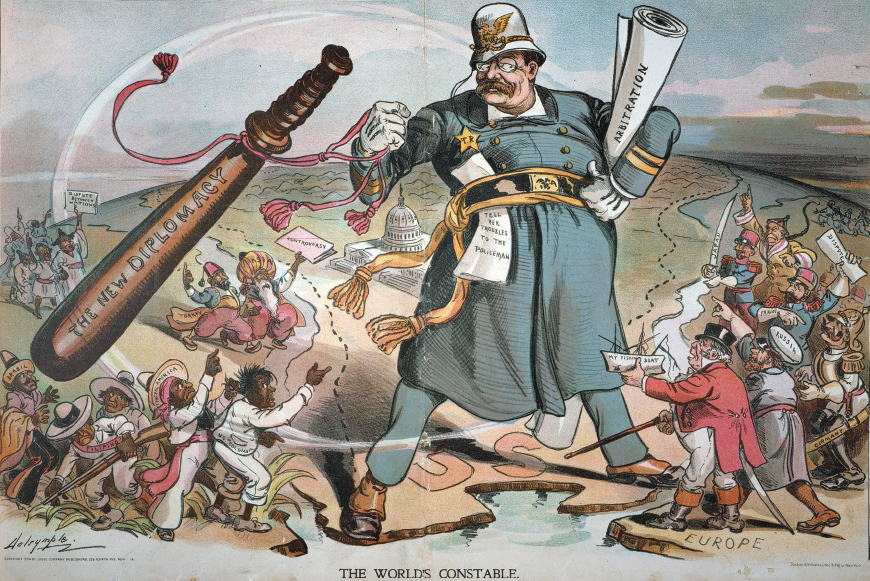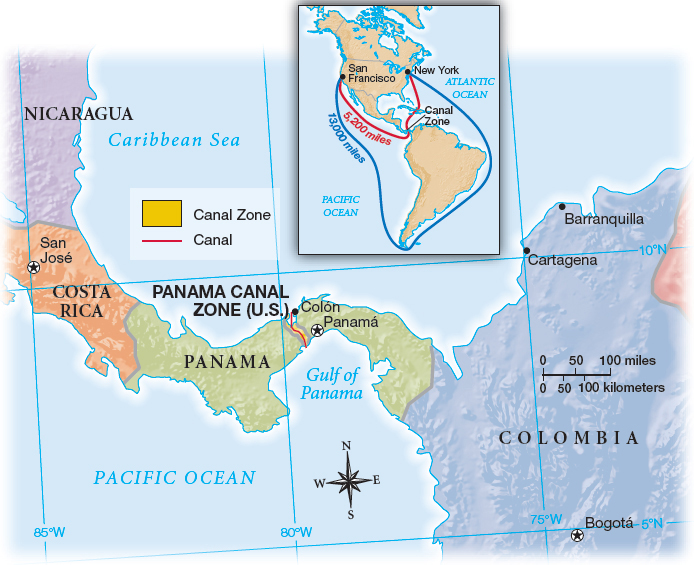The Big Stick
Printed Page 624
Roosevelt’s activism extended to his foreign policy. A fierce proponent of America’s interests abroad, he relied on executive power to pursue a vigorous foreign policy, sometimes stretching the powers of the presidency beyond legal limits. In his relations with the European powers, he relied on military strength and diplomacy, a combination he aptly described with the aphorism “Speak softly but carry a big stick.”

CHAPTER OVERVIEW
How did grassroots progressives attack the problems of industrial America?
What were the key tenets of progressive theory?
How did Theodore Roosevelt advance the progressive agenda?
How did progressivism evolve during Woodrow Wilson’s first term?
What were the limits of progressive reform?
Conclusion: How did the liberal state transform during the Progressive Era?
 LearningCurve
LearningCurve
Check what you know.
A strong supporter of the Monroe Doctrine, Roosevelt jealously guarded the U.S. sphere of influence in the Western Hemisphere. His proprietary attitude toward the Caribbean became evident in the case of the Panama Canal. Roosevelt had long been a supporter of a canal linking the Caribbean and the Pacific. By enabling ships to move quickly from the Atlantic to the Pacific, a canal would trim 8,000 miles from a coast-to-coast voyage and effectively double the U.S. Navy’s power. Having decided on a route across the Panamanian isthmus (a narrow strip of land connecting North and South America), then part of Colombia, Roosevelt in 1902 offered the Colombian government a one-time sum of $10 million and an annual rent of $250,000. When the government in Bogotá refused to accept the offer, Roosevelt became incensed at what he called the “homicidal corruptionists” in Colombia for trying to “blackmail” the United States. At the prompting of a group of New York investors, the Panamanians staged an uprising in 1903, and with unseemly haste the U.S. government recognized the new government within twenty-four hours. The Panamanians promptly accepted the $10 million, and the building got under way. The canal would take eleven years and $375 million to complete; it opened in 1914 (Map 21.2).

In the wake of the Panama affair, a confrontation with Germany over Venezuela, and yet another default on a European debt, this time in the Dominican Republic, Roosevelt grew concerned that financial instability in Latin America would lead European powers to interfere. In 1904, he announced the Roosevelt Corollary to the Monroe Doctrine.
 Theodore Roosevelt’s 1904 follow-up to the Monroe Doctrine in which he declared that the United States had the right to intervene in Latin America to stop “brutal wrongdoing” and protect American interests. The corollary warned European powers to keep out of the Western Hemisphere.
Theodore Roosevelt’s 1904 follow-up to the Monroe Doctrine in which he declared that the United States had the right to intervene in Latin America to stop “brutal wrongdoing” and protect American interests. The corollary warned European powers to keep out of the Western Hemisphere.
CHAPTER OVERVIEW
How did grassroots progressives attack the problems of industrial America?
What were the key tenets of progressive theory?
How did Theodore Roosevelt advance the progressive agenda?
How did progressivism evolve during Woodrow Wilson’s first term?
What were the limits of progressive reform?
Conclusion: How did the liberal state transform during the Progressive Era?
 LearningCurve
LearningCurve
Check what you know.
Roosevelt Corollary
> Roosevelt Corollary
- The United States had a right to act as “an international police power” in the Western Hemisphere.
- The United States would not intervene in Latin America as long as nations there conducted their affairs with “decency,” but it would step in to stop “brutal wrongdoing.”
- The Roosevelt Corollary served notice to European powers to stay out of the Western Hemisphere.
In Asia, Roosevelt inherited the Open Door policy initiated by Secretary of State John Hay in 1899, designed to ensure U.S. commercial entry into China. As European powers raced to secure Chinese trade and territory, Roosevelt was tempted to use force to gain economic or possibly territorial concessions. Realizing that Americans would not support an aggressive Asian policy, the president sensibly held back.

In his relations with Europe, Roosevelt sought to establish the United States as a rising force in world affairs. When tensions flared between France and Germany in Morocco in 1905, Roosevelt mediated at a conference in Algeciras, Spain, where he worked to maintain a balance of power that helped neutralize German ambitions. His skillful mediation gained him a reputation as an astute player on the world stage and demonstrated the nation’s new presence in world affairs.
Roosevelt earned the Nobel Peace Prize in 1906 for his role in negotiating an end to the Russo-Japanese War, which had broken out when the Japanese invaded Chinese Manchuria, threatening Russia’s sphere of influence in the area. Once again, Roosevelt sought to maintain a balance of power, in this case working to curb Japanese expansionism. Roosevelt admired the Japanese, judging them “the most dashing fighters in the world,” but he did not want Japan to become too strong in Asia.
When good relations with Japan were jeopardized by discriminatory legislation in California calling for segregated public schools for Asians, Roosevelt smoothed over the incident and negotiated the “Gentlemen’s Agreement” in 1907, which allowed the Japanese to save face by voluntarily restricting immigration to the United States. To demonstrate America’s naval power and to counter Japan’s growing bellicosity, Roosevelt dispatched the Great White Fleet, sixteen of the navy’s most up-to-date battleships, on a “goodwill mission” around the world. U.S. relations with Japan improved, and in the 1908 Root-Takahira agreement the two nations pledged to maintain the Open Door and support the status quo in the Pacific. Roosevelt’s show of American force constituted a classic example of his dictum “Speak softly but carry a big stick.”